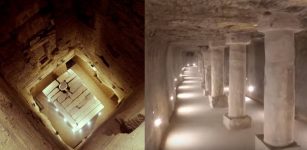‘Giants’ Discovered In Ancient Grave In China
Jan Bartek - AncientPages.com - Whether these ancient skeletons should be considered "giants" is a matter of opinion, but Chinese archaeologists have labeled these bones - remains of "giants."
In a country of relatively short people, it's understandable the discovery of unusually tall and strong people is very surprising.
Archaeologists unearthed people who were surprisingly tall. Image credit: People's Daily Online
While excavating in east China, scientists examined bones from graves in Shandong Province.
The bones are 5,000 years old and belong to people who were above average height. One of the deceased persons was 1.9 meters (6-foot-3-inches), and the other was 1.8 meters or taller.
"This is just based on the bone structure. If he was a living person, his height would certainly exceed 1.9 meters," said Fang Hui, head of Shandong University's School of History and Culture.
According to official statistics, in 2015, the average height of men aged 18 in Shandong was 1.753 meters, compared with a national average of 1.72 meters.
So, how is it possible that people living in this area were of much taller 5,000 years ago? It seems taller men were common in this part of China. Confucius (551-479 B.C.), a native of the region, was said to be about 1.9 meters tall. Confucius was buried in the Kong Lin cemetery, which lies in the historical part of Qufu in the Shandong Province.
Scientists think one explanation can be related to food and wealth.
Ruins of rows of houses in the area indicate that people lived quite comfortable lives, with separate bedrooms and kitchens. They had crops and pigs, and the area was believed to be the political, economic, and cultural center of northern Shandong 5,000 years ago.
Better food could explain why some people were taller, scientists think. Image credit: People's Daily Online
Archaeologists suggests that taller men were found in larger tombs, possibly because such people had a high status and were able to acquire better food.
Colorful pottery and jade artifacts were placed in the tombs. Some of the bones and artifacts were damaged.
The damage may have been done not long after the burials and may be due to power struggles among high-ranking people.
Li Boqian, an archaeologist with Peking University, said the excavations showed Jiaojia in a transition phase but proved the existence of ancient states 5,000 years ago in the basin of the lower Yellow River.
The range of the Jiaojia site has been enlarged from an initial 240,000 square meters to 1 sq km. Currently, only 2,000 square meters has been excavated.
"Further study and excavation of the site is of great value to our understanding of the origin of culture in East China," said Zhou Xiaobo, deputy head of the Shandong provincial bureau of cultural heritage.
Written by Jan Bartek - AncientPages.com Staff Writer
Expand for references





















